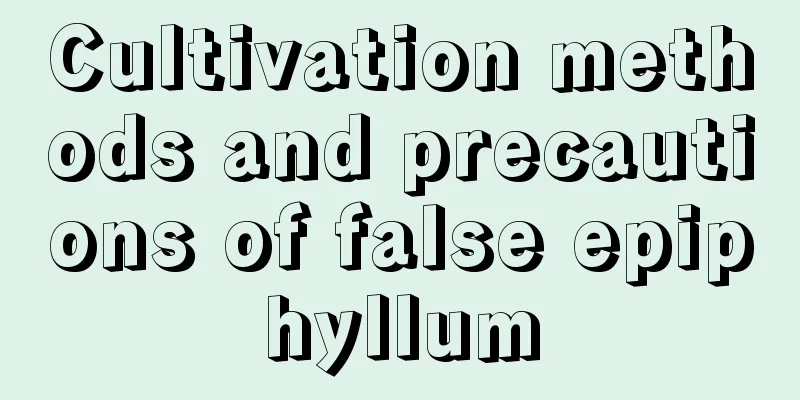Cultivation methods and precautions of false epiphyllum

How to grow false epiphyllumLight and temperatureWhen cultivating the false epiphyllum, you need to note that the false epiphyllum likes a semi-shaded growing environment, but the growth of the flower buds of the false epiphyllum requires 8 hours of light a day, so when cultivating, except in summer, you must ensure sufficient light. In winter, you can place it in a sunny place indoors for maintenance. In summer, you need to avoid sunlight exposure. It is best to place it in a ventilated and cool place indoors for maintenance. The maintenance temperature should be kept in a warmer range, about 15℃-25℃, and the temperature for wintering should not be lower than 10℃. Pot soilWhen planting and cultivating Epiphyllum, you can choose a flowerpot with a diameter of 10cm-15cm. When potting, you can use leaf mold, peat soil and river sand. Fill some broken tiles at the bottom of the pot to enhance air permeability and drainage. If you are growing the plant in a hanging pot, you can use moss as the substrate. Watering and fertilizingWater and fertilizer management is very important for the growth of Epiphyllum. The false epiphyllum needs sufficient water and fertilizer, and the soil in the pot needs to be kept moist, but not waterlogged. Note that after flowering and during dormancy, you should reduce watering and keep the soil moist. After the dormancy period, you can gradually increase watering. In addition, because the false epiphyllum prefers a humid environment, you should pay attention to spraying water around the plant frequently when cultivating it. As for fertilization, you can apply decomposed thin liquid fertilizer once a month. During the dormant period after flowering, reduce fertilization and prune the branches. Precautions for the cultivation of false epiphyllumRepottingRepotting is to make the false night-blooming cereus grow better. It is usually done in late spring or early summer, and once every two years. When repotting, you can remove the old soil and replace it with new soil, making sure the soil contains rich humus. Pests and diseasesThe main diseases of false epiphyllum are leaf spot and wilt, which can be treated by spraying 50% carbendazim. The insect pest of false epiphyllum is red spider mites, which can be sprayed with 40% malathion emulsifiable concentrate solution. |
<<: Cultivation methods and precautions of peacock grass
>>: When does the Fire Festival bloom?
Recommend
What is Luo Han Guo, Luo Han Guo pictures
1. Introduction Luo Han Guo is the fruit of the p...
Cultivation methods and precautions of chestnuts
Chestnuts are easy to grow, but the planting meth...
When is the best time to propagate rose cuttings (how to propagate potted rose cuttings to achieve a high survival rate)
Which month is best for rose cuttings? There are ...
What should I do if the roots of my bird of paradise turn yellow?
When you notice that the roots of your bird of pa...
Can mangoes be grown in Guangxi?
Can mangoes be grown in Guangxi? Mangoes can be g...
Is loess or nutrient soil better for camellia? Special soil formula and preparation method for camellia
Is it better to plant camellia in nutrient soil o...
Balcony placement and maintenance of petunias in four seasons
Spring placement and care of petunias In spring, ...
Pumpkin seed germination method Germination time and steps
Pumpkin seeds have a certain dormancy period befo...
How to propagate the rich tree
About root propagation The fortune tree mainly re...
Cauliflower planting time and method
Cauliflower planting time Cauliflower is generall...
How to grow Elaeocarpus edulis well
1. Maintenance methods 1. Temperature: Elaeocarpu...
How to grow Astragalus
1. Maintenance methods 1. Temperature: 15 to 25 d...
How long does it take for hyacinth to grow roots and bloom in hydroponics?
1. How long does it take for hyacinth to grow roo...
There are several types of spider plants.
1. Chlorophytum comosum As its name suggests, the...
How many years does it take for tea oil trees to bear fruit?
Introduction to Planting Tea Oil Trees Tea oil tr...









